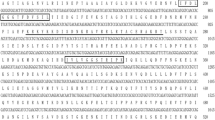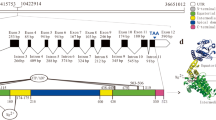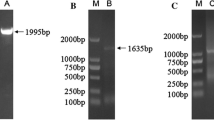Abstract
In this study, the cDNA sequences of HSP70 and HSP90 were isolated from the special chondr-ganoid scale, Amur sturgeon, for the first time. Homology analysis indicated that amino acid sequences of HSP70 and HSP90 shared high identity with other species (82.68–99.07 and 90.19–98.07 %, respectively). The tissue expression analysis showed that the asHSP70 and asHSP90 mRNA were ubiquitously expressed in all the examined tissues under unstressed condition. The expression pattern of HSP70 and HSP90 under chronic (crowding) and acute (hypoxia) stress was examined by q-PCR in liver, spleen and kidney. Results showed that stocking density could significantly influence the expression of HSP70 at day 20 and/or day 40. In contrast to stocking density, levels of HSP70 transcripts indicated a remarkable increase in all examined tissues after hypoxia stress. HSP90 levels in liver and spleen increased significantly in high stocking density. By comparison, significant increase of asHSP90 in kidney was only found in high stocking density at day 40. Similar to HSP70, the levels of HSP90 transcripts showed significant increases after hypoxia stress except the transcript of liver in H2 group 6 h after hypoxia. The assessment of asHSP70 and asHSP90 mRNA levels under crowding and hypoxia stresses indicated that asHSP70 and asHSP90 gene might be good indicators of stressful situations for Amur sturgeon. Taking serum globulin and electrolytes account, we suggest that crowding and hypoxia stress can result in considerable stress for Amur sturgeon.










Similar content being viewed by others
References
Agrahari S, Pandey KC, Gopal K (2007) Biochemical alteration induced by monocrotophos in the blood plasma of fish Channa punctatus (Bloch). Pestic Biochem Physiol 88:268–272
Airaksinen A, Rabergh CMI, Sistonen L, Nikinmaa M (1998) Effects of heat shock and hypoxia on protein synthesis in rainbow trout (Oncorhynchus mykiss) cells. J Exp Biol 201:2543–2551
Aksakal E, Ekinci D, Erdoğan O, Beydemir S, Alım Z, Ceyhun SB (2011) Increasing stocking density causes inhibition of metabolic–antioxidant enzymes and elevates mRNA levels of heat shock protein 70 in rainbow trout. Livest Sci 141:69–75
Alfredo M, Frederic B, Ferenc M (2000) Cloning and expression analysis of an inducible HSP70 gene from tilapia fish. FEBS Lett 474:5–10
Basu N, Todgham AE, Ackerman PA, Bibeau MR, Nakano K, Schulte PM, Iwama GK (2002) Heat shock protein genes and their functional significance in fish. Gene 295:173–183
Bemis WE, Findeis EK, Grande L (1997) An overview of Acipenseriformes. Environ Biol Fishes 48:25–71
Biswas AK, Seoka M, Takii K, Maita M, Kumai H (2006) Stress response of red sea bream Pagrus major to acute handling and chronic photoperiod manipulation. Aquaculture 252:566–572
Bukau B, Horwich AL (1998) The HSP70 and Hsp60 chaperone machines. Cell Pres 92:351–366
Caipang CMA, Brinchmann MF, Berg I, Iversen M, Eliassen R, Kiron V (2008) Changes in selected stress and immune–related genes in Atlantic cod, Gadus morhua, following overcrowding. Aquacult Res 39:1533–1540
Dang W, Hu Y, Zhang M, Sun L (2010) Identification and molecular analysis of a stress–inducible HSP70 from Sciaenops ocellatus. Fish Shellfish Immunol 29:600–607
Deane EE, Woo NYS (2010) Growth hormone attenuates branchial HSP70 expression in silver sea bream. Fish Physiol Biochem 36:135–140
Demand J, Lüders J, Höhfeld J (1998) The carboxy–terminal domain of Hsc70 provides binding sites for a distinct set of chaperone cofactors. Mol Cell Biol 18(4):2023–2028
Douxfils J, Deprez M, Mandiki SN, Milla S, Henrotte E, Mathieu C, Silvestre F, Vandecan M, Rougeot C, Mélard C, Dieu M, Raes M, Kestemont P (2012) Physiological and proteomic responses to single and repeated hypoxia in juvenile Eurasian perch under domestication–clues to physiological acclimation and humoral immune modulations. Fish Shellfish Immunol 33(5):1112–1122
Ellis T, North B, Scott AP, Bromage NR, Porter M, Gadd D (2002) The relationships between stocking density and welfare in farmed rainbow trout. J Fish Biol 61:493–531
Feder ME, Hofmann GE (1999) Heat–shock proteins, molecular chaperones, and the stress response: evolutionary and ecological physiology. Annu Rev Physiol 61:243–282
Gamperl AK, Vijayan MM, Pereira C, Farrell AP (1998) β-Receptors and stress protein 70 expression in hypoxic myocardium of rainbow trout and chinook salmon. Am J Physiol 274:428–436
Gething MJ, Sambrook J (1992) Protein folding in the cell. Nature 355:33–45
Gornati R, Papis E, Rimoldi S, Terova G, Saroglia M, Bernardini G (2004a) Rearing density influences the expression of stress–related genes in sea bass (Dicentrarchus labrax, L). Gene 341:111–118
Gornati R, Terova G, Vigetti D, Prati M, Saroglia M, Bernardini G (2004b) Effects of population density on seabass (Dicentrarchus labrax L.) gene expression. Aquaculture 230:229–239
Gupta RS (1995) Phylogenetic analysis of the 90 kD heat shock family of protein sequences and an examination of the relationship among animals, plants and fungi species. Mol Biol Evol 12(6):1063–1073
Hrubec TC, Smith SA, Robertson JL, Feldman B, Veit HP, Libey G, Tinker MK (1996) Blood biochemical reference intervals for sunshine bass (Morone chrysops × Morone saxatilis) in three culture systems. Am J Vet Res 57:624–627
Hrubec TC, Cardinale JL, Smith SA (2000) Hematology and plasma chemistry reference intervals for cultured tilapia (Oreochromis hybrid). Vet Clin Pathol 29:7–12
Huang Y, Cai X, Zou Z, Wang S, Wang G, Wang Y, Zhang Z (2014) Molecular cloning, characterization and expression analysis of three heat shock responsive genes from Haliotis diversicolor. Fish Shellfish Immunol 36(2):590–599
Imorou T, Emile D, Fiogbe BK, Patrick K (2007) Rearing of African catfish (Clarias gariepinus) and vundu catfish (Heterobranchus longifilis) in traditional fish ponds (whedos): effect of stocking density on growth, production and body composition. Aquaculture 262:165–172
Joly AL, Wettstein G, Mignot G, Ghiringhelli F, Garrido C (2010) Dual role of heat shock proteins as regulators of apoptosis and innate immunity. J Innate Immun 2:238–247
Kiang JG, Tsokos GC (1998) Heat Shock Protein 70 kDa: molecular biology, biochemistry, and physiology. Pharmacol Therapeut 80:183–201
Li F, Luan W, Zhang C, Zhang J, Wang B, Xie Y, Li S, Xiang J (2009) Cloning of cytoplasmic heat shock protein 90 (FcHSP90) from Fenneropenaeus chinensis and its expression response to heat shock and hypoxia. Cell Stress Chaperon 14(2):161–172
Li XF, Liu WB, Lu KL, Xu WN, Wang Y (2012) Dietary carbohydrate/lipid ratios affect stress, oxidative status and non–specific immune responses of fingerling blunt snout bream, Megalobrama amblycephala. Fish Shellfish Immunol 33:316–323
Lindquist S, Craig EA (1988) The heat–shock proteins. Annu Rev Genet 22:631–677
Livak KJ, Schmittgen TD (2002) Analysis of relative gene expression data using real-time quantitative PCR and the 2−ΔΔCT method. Methods 25:402–408
Lückstädt C, Schill RO, Focken U, Köhler HR, Becker K (2004) Stress protein HSP70 response of Nile Tilapia Oreochromis niloticus (Linnaeus, 1758) to induced hypoxia and recovery. Verh Ges Ichthyol Bd 4:137–141
Ludwig A (2008) Identification of Acipenseriform species in trade. J Appl Ichthyol 24:2–19
Ma KX, Chen GW, Liu DZ (2012) cDNA cloning of heat shock protein 90 gene and protein expression pattern in response to heavy metal exposure and thermal stress in planarian Dugesia japonica. Mol Biol Rep 39:7203–7210
Marber MS, Mestril R, Chi SH, Sayen R, Yellon DM, Dillmann WH (1995) Overexpression of the rat inducible 70-kD stress protein in a transgenic mouse increases the resistance of the heart to ischemic injury. J Clin Invest 95:1446–1456
Martinovic D, Villeneuve DL, Kahl MD, Blake LS, Brodin JD, Ankley GT (2009) Hypoxia alters gene expression in the gonads of zebrafish (Danio rerio). Aquat Toxicol 95:258–272
Ming JH, Xie J, Xu P, Liu WB, Ge XP, Liu B, He YJ, Cheng YF, Zhou QL, Pan LK (2010) Molecular cloning and expression of two HSP70 genes in the Wuchang bream (Megalobrama amblycephala Yih). Fish Shellfish Immunol 28(3):407–418
Montero D, Izquierdo MS, Tort L, Robaina L, Vergara JM (1999) High stocking density produces crowding stress altering some physiological and biochemical parameters in gilthead seabream, Sparus aurata, juveniles. Fish Physiol Biochem 20:53–60
Mu W, Wen H, Li J, He F (2013) Cloning and expression analysis of a HSP70 gene from Korean rockfish (Sebastes schlegeli). Fish Shellfish Immunol 35(4):1111–1121
Mulero I, Garciae-Ayala A, Meseguer J, Mulero V (2007) Maternal transfer of immunity and ontogeny of autologous immunocompetence of fish: a mini review. Aquaculture 268:244–250
Neckers L, Ivy SP (2003) Heat shock protein 90. Curr Opin Oncol 15:419–424
Ni M, Wen H, Li J, Chi M, Bu Y, Ren Y, Zhang M, Song Z, Ding H (2013) The physiological performance and immune responses of juvenile Amur sturgeon (Acipenser schrenckii) to stocking density and hypoxia stress. Fish Shellfish Immunol 36(2):325–335
North BP, Turnbull JF, Ellis T (2006) The impact of stocking density on the welfare of rainbow trout (Oncorhynchus mykiss). Aquaculture 255:466–479
Palmisano AN, Winton JR, Dickhoff WW (2000) Tissue-specific induction of HSP90 mRNA and plasma cortisol response in chinook salmon following heat shock, seawater challenge, and handling challenge. Mar Biotechnol 2:329–338
Picard D (2002) Heat-shock protein 90, a chaperone for folding and regulation. Cell Mol Life Sci 59:1640–1648
Pockley AG (2003) Heat shock proteins as regulators of the immune response. Lancet 362:469–476
Pratt WB (1997) The role of the HSP90 based chaperone system in signal transduction by nuclear receptors and receptor signaling via map kinase. Annu Rev Pharmacol Toxicol 37:297–326
Rehulka J (2000) Influence of astaxanthin on growth rate condition and some blood indexes of rainbow trout Oncorhynchus mykiss. Aquaculture 190:27–47
Roque A, Yildiz HY, Carazo I, Duncan N (2010) Physiological stress responses of sea bass (Dicentrarchus labrax) to hydrogen peroxide (H2O2) exposure. Aquaculture 304:104–107
Saitou N, Nei M (1987) The neighbor–joining method: a new method for reconstructing phylogenetic trees. Mol Biol Evol 4:406–425
Salas-Leiton E, Anguis V, Martín-Antonio B, Crespo D, Planas JV, Infante C, Cañavate JP, Manchado M (2010) Effects of stocking density and feed ration on growth and gene expression in the Senegalese sole (Solea senegalensis): potential effects on the immune response. Fish Shellfish Immunol 28:296–302
Schram E, Van der Heul JW, Kamstra A, Verdegem MCJ (2006) Stocking density-dependent growth of Dover sole (Solea solea). Aquaculture 252:339–347
Schreck CB, Olla BL, Davis MW (1997) Behavioral responses to stress. In: Iwama GK, Pickering AD, Sumpter JP, Schreck CB (eds) Fish stress and health in aquaculture society for experimental biology seminar series, vol 62. Cambridge University Press, Cambridge, pp 145–170
Sørensen JG, Kristensen TN, Loeschcke V (2003) The evolutionary and ecological role of heat shock proteins. Ecol Lett 6:1025–1037
Su XR, Du LL, Li YY, Li Y, Zhou J, Li TW (2010) Cloning and expression of HSP70 gene of sipuncula Phascolosoma esculenta. Fish Shellfish Immunol 28:461–466
Tamura K, Dudley J, Nei M, Kumar S (2007) MEGA4: molecular evolutionary genetics analysis (MEGA) software version 4.0. Mol Biol Evol 24:1596–1599
Thompson JD, Higgins DG, Gibson TJ (1994) CLUSTAL W: improving the sensitivity of progressive multiple sequence alignment through sequence weighting, position specific gap penalties and weight matrix choice. Nucleic Acids Res 22:4673–4680
Ton C, Stamatiou D, Dzau VJ, Liew CC (2002) Construction of a zebrafish cDNA microarray: gene expression profiling of the zebrafish during development. Biochem Biophys Res Commun 296:1134–1142
Tsan M, Gao B (2004) Cytokine function of heat shock proteins. Am J Physiol Cell Physiol 286:739–744
Wallin RP, Lundqvist A, More SH, Von Bonin A, Kiessling R, Ljunggren HG (2002) Heat-shock proteins as activators of the innate immune system. Trends Immunol 23:130–135
Weigl E, Kopecek P, Raska M, Hradilova S (1999) Heat shock proteins in immune reactions. Folia Microbiol 44:561–566
Wu RS (2002) Hypoxia: from molecular responses to ecosystem responses. Mar Pollut Bull 45:35–45
Yang DG, Zhu YJ, Luo YP, Zhao JH, Chen JW (2011) Effect of stocking density on growth performance of juvenile Amur Sturgeon (Acipenser schrenckii). J Appl Ichthyol 27:541–544
Yue X, Liu B, Sun L, Tang B (2011) Cloning and characterization of a HSP70 gene from Asiatic hard clam Meretrix meretrix which is involved in the immune response against bacterial infection. Fish Shellfish Immunol 30:791–799
Zhuang P, Kynard B, Zhang L, Zhang T, Zhang Z, Li D (2002) Overview of biology and aquaculture of Amur sturgeon (Acipenser schrenckii) in China. J Appl Ichthyol 18:659–664
Acknowledgments
This research was supported by Special Fund for Agro-scientific Research in the Public Interest (201003055).
Author information
Authors and Affiliations
Corresponding author
Rights and permissions
About this article
Cite this article
Ni, M., Wen, H., Li, J. et al. Two HSPs gene from juvenile Amur sturgeon (Acipenser schrenckii): cloning, characterization and expression pattern to crowding and hypoxia stress. Fish Physiol Biochem 40, 1801–1816 (2014). https://doi.org/10.1007/s10695-014-9969-9
Received:
Accepted:
Published:
Issue Date:
DOI: https://doi.org/10.1007/s10695-014-9969-9




